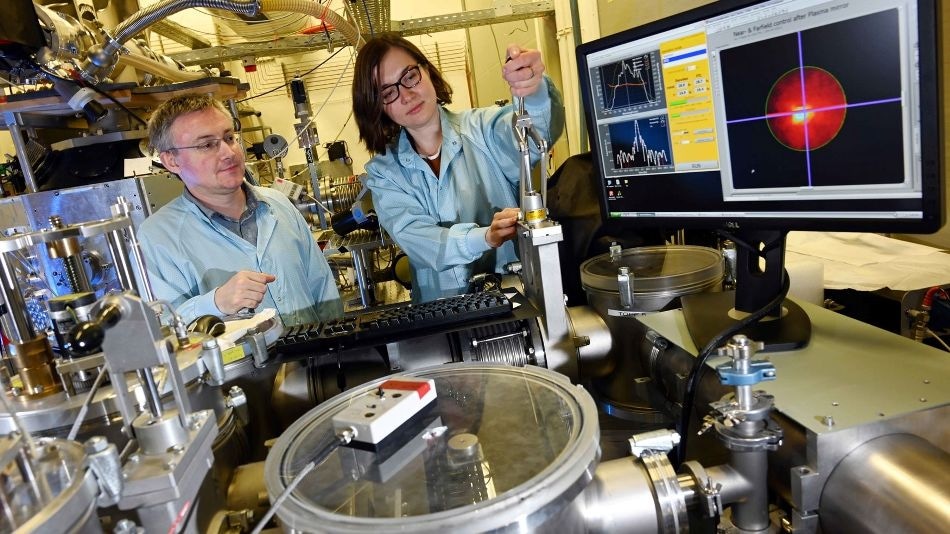Jun 6 2019
Physicists from the University of Jena have devised a new technique for synthesizing plasma, which allows them to overcome certain challenges encountered while performing this highly difficult process.
 Dr Zhanna Samsonova and Dr Daniil Kartashov in a laser lab. (Image credit: Jan-Peter Kasper/FSU)
Dr Zhanna Samsonova and Dr Daniil Kartashov in a laser lab. (Image credit: Jan-Peter Kasper/FSU)
It is possible to observe the three classic physical states—solid, liquid, and gaseous—in any normal kitchen, for instance, while bringing an ice cube to the boil. However, upon heating the material further, such that the atoms of a substance collide and the electrons isolate from them, then another state is attained—plasma.
Over 99% of the material in space exists in this form, within stars for instance. Hence, it is not surprising that physicists are eager to investigate such material. Sadly, production and analysis of plasmas on Earth using the high pressure and temperature that occur within stars are highly difficult due to a number of reasons.
Currently, physicists from Friedrich Schiller University in Jena have managed to overcome some of these challenges. The study outcomes have been published in the distinguished research journal Physical Review X.
Nanowires Let Light Through
To heat material in such a way that plasma is formed, we need correspondingly high energy. We generally use light in the form of a large laser to do this. However, this light has to be very short-pulsed, so that the material does not immediately expand when it has reached the appropriate temperature, but holds together as dense plasma for a brief period.
Christian Spielmann, University of Jena
However, this experimental setup poses a problem: “When the laser beam hits the sample, plasma is created. However, it almost immediately starts to act like a mirror and reflects a large part of the incoming energy, which therefore fails to penetrate the matter fully. The longer the wavelength of the laser pulse, the more critical the problem,” stated Zhanna Samsonova, who played a leading role in the study.
The Jena researchers eliminated this mirror effect by using samples made of silicon wires. Such wires have a diameter of a few hundred nanometers, which is smaller than the wavelength of the incoming light, which is nearly 4 μm.
We were the first to use a laser with such a long wavelength for the creation of plasma. The light penetrates between the wires in the sample and heats them from all sides, so that for a few picoseconds, a significantly larger volume of plasma is created than if the laser is reflected. Around 70 per cent of the energy manages to penetrate the sample.
Christian Spielmann, University of Jena
Moreover, the short laser pulses allowed the heated material to exist somewhat longer before it could expand. Eventually, researchers can use X-ray spectroscopy to retrieve valuable information related to the state of the material.
Maximum Values for Temperature and Density
“With our method, it is possible to achieve new maximum values for temperature and density in a laboratory,” stated Spielmann. The plasma has a temperature of about 10 million Kelvin and is quite hotter compared to material on the surface of the Sun, for instance. Spielmann has also mentioned about the cooperation partners in the study.
The Jena researchers performed the laser experiments by using a facility at the Vienna University of Technology, the samples were obtained from the National Metrology Institute of Germany in Braunschweig, and computer simulations for validating the study outcomes were obtained from colleagues in Darmstadt and Düsseldorf.
The outcomes of the study by the Jena researchers are a pathbreaking success, providing a totally new strategy toward plasma research. It is possible to verify the theories on the state of plasma through experiments and subsequent computer simulations. This will allow scientists to gain better insights into cosmological processes.
Furthermore, the researchers are performing valuable preparatory work for installing large-scale apparatus. For instance, at present, the international particle accelerator, “Facility for Antiproton and Ion Research” (FAIR), is being set up in Darmstadt and should become operational by 2025. The new information will make it possible to choose particular areas that deserve closer investigation.